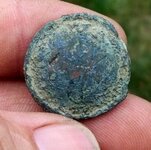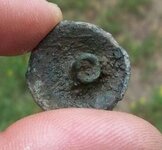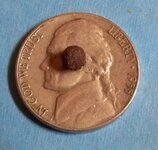West Jersey Detecting
Gold Member
SEE UPDATED PHOTO AND ID IN REPLY AT END OF THREAD
I finally got a chance to try the TDI Pro today. It picks up the tiniest targets, but definitely has a learning curve. After a while at a "hunted out site" I decided call it a day. On the way home I decided to check out a school that is on the route that Clinton's men took on their way to Monmouth in June of 1778. I found nothing but modern coinage and the usual can slaw until I got a signal that I thought sounded like a button and dug this old pewter low convex button. It seems to be military, but is too far gone for me to ID, so I am hoping that someone in the forum recognizes it.
(IP are you reading this?) I can also use some advice on preserving it...It is already flaking!


Here is an example of the size of some targets that the TDI was finding (and it was not on the most sensitive pulse delay):

I finally got a chance to try the TDI Pro today. It picks up the tiniest targets, but definitely has a learning curve. After a while at a "hunted out site" I decided call it a day. On the way home I decided to check out a school that is on the route that Clinton's men took on their way to Monmouth in June of 1778. I found nothing but modern coinage and the usual can slaw until I got a signal that I thought sounded like a button and dug this old pewter low convex button. It seems to be military, but is too far gone for me to ID, so I am hoping that someone in the forum recognizes it.
(IP are you reading this?) I can also use some advice on preserving it...It is already flaking!


Here is an example of the size of some targets that the TDI was finding (and it was not on the most sensitive pulse delay):

Upvote
0















